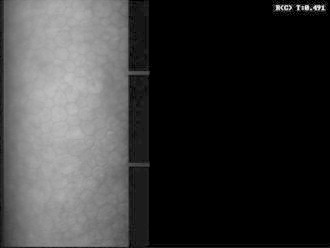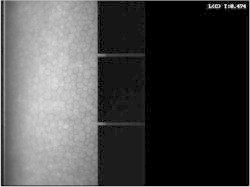Abstract
Purpose
To raise the issue of increased use of traditional medicine while the Tertiary care hospitals are available to provide the appropriate care for each clinical condition. Eyeliner (Kohl) is an Arabic word denoting a fine powder with a texture and appearance similar to mascara. It is usually worn on the lid margins or inside the conjunctival sac by Middle and Far Eastern and in East Africans populations for different purposes like beauty or religious and as a treatment for many eye diseases.
Summary
We report a case of a lady who put traditional locally prepared eyeliner in her eye that resulted in severe corneal edema and faint scaring. On toxicology analysis it was discovered to contain toxic levels of Cadmium (Cd) and Lead (Pb).
Conclusion
Cd is a heavy toxic metal like Pb but has never been reported as a component of eyeliners. The most likely possible cause of the corneal clinical picture in our case is due to the toxic effect of Cd found in the traditional eyeliner (Kohl) used in Saudi Arabia.
Keywords: Toxic effect, Cadmium, Eye, Eyeliner, Kohl
1. Introduction
Eyeliner (Kohl) is an Arabic word denoting a fine powder with a texture and appearance similar to mascara. It is usually worn on the lid margins or inside the conjunctival sac by Middle and Far Eastern and in East Africans populations for different purposes like beauty or religious and as a treatment for many eye diseases (Al-Hazzaa and Krahn, 1995).
Its main component is Galena (Lead sulfide) Mahmood et al., 2009 and in some preparations it contains herbs and some types of crystals (Erie et al., 2005).
Cadmium (Cd) is a heavy toxic metal like Lead (Pb) but has never been reported as a component of eyeliners.
We report a case of a lady who puts traditional locally prepared eyeliner in her eye that resulted in severe corneal edema and faint scaring. On toxicology analysis it was discovered to contain toxic levels of Cd and Pb.
We presume this is the first report of such toxic effect of Cd to the human being eye.
2. Case presentation
The 21 years old Saudi Arabian lady was referred to our hospital from a local hospital with a case of severe keratitis in her right eye after using a locally prepared eye linear (Kohl) prescribed by a local herbalist for her red eye 2 weeks prior to her referral. Kohl was provided by herbalist in commercial container without brand or composition details. Patient had put a large amount of the eyeliner inside the eye rather on the lid margins for about one week as per the advice of the herbalist. No history of ocular trauma, contact lens wear or systemic diseases was reported. On her examination in the emergency room she had visual acuity (VA) of counting fingers at 2 feet in the right eye (OD), and 20/20 in the left eye (OS). OS Intra-ocular pressure (IOP) was 17 millimeter mercury (mmHg). OD IOP was not recorded.
Slit lamp examination OD showed swollen eye lids, severe conjunctival congestion, small corneal infiltrate with overlying epithelial defect, anterior chamber was deep with no hypopion with no further details; fundus was flat. OS examination was within normal limits.
The working diagnosis was infectious keratitis OD for which corneal scraping was done and specimens sent for Gram and Giemsa staining plus culture and sensitivity testing. Patient was hospitalized and started on topical fortified Cephazoline 50 milligram/milliliter (mg/ml) and ceftazidime 50 mg/ml alternating every 4 h, and Erythromycin eye ointment at bed time plus cyclopentolate 1% drops three times/day.
Initial Gram and Giemsa staining results showed no organisms. On the following day she was evaluated by an anterior segment faculty member and labeled as mild keratitis with epithelial defect. The antibiotics frequency was reduced and was started on topical flouromethalone drops (FML) four times a day after 3 days of admission to the hospital. The results of culture were negative after 37 h and a dramatic improvement recorded over one week after which she was discharged on ofloxacin, FML and lubricating drops.
A week later patient presented to the emergency room complaining of severe ocular pain and tearing and found to have a corneal epithelial defect with no infiltrate, although she had a localized corneal edema with quiet anterior chamber (Fig. 1), the rest of the examination was unremarkable.
Figure 1.

Biomicroscopy photo of right eye cornea at the initial presentation showing cloudy cornea.
Her condition was diagnosed as toxic keratitis and she was requested to bring a sample of the material she had used as eyeliner (Fig. 2). For social reasons she was admitted to the hospital and the sample was sent to King Faisal Specialist Hospital and Research Center (KFSHRC) which is a tertiary center with national toxicology reference in Riyadh for further testing.
Figure 2.

Photo of the sample of the used eye liner (Kohl) showing the pink color on finger.
Patient was started on topical prednisolone acetates 1% drops (PREDFORTE), Sodium chloride drops 5% in addition to topical lubricating eye drops and ointment at bed time.
She improved symptomatically in regard to the ocular pain. The epithelial defect healed completely. The results of the sample recorded an eye linear (Kohl) containing toxic levels of heavy metals (Pb: 307,562,348 parts per million (ppm) and Cd: 6259 ppm) and trace levels of Mercury and Thallium. The testing method used was gas chromatography/mass spectrometry (GC/MS). The herbalist lives outside city of Riyadh and due to social and legal constraints the female traditional herbalist was not contacted. The patient was informed about the nature of the used eyeliner and highly advised not to use it in future. The corneal endothelial cell count was low OD, 1361 (per square millimeter (mm2)) (Fig. 3a), and normal OS 2943 mm−2 (Fig. 3b).
Figure 3a.

Specular microscopy photo of the right eye showing the distorted shape of the endothelial cells.
Figure 3b.

Specular microscopy photo of the normal left eye showing normal appearance of the endothelial cells.
On last follow up, patient had 20/20 vision despite faint scaring with no corneal edema (Fig. 4).
Figure 4.

Slit Lamb photo of the almost normal cornea at 3 months later.
3. Discussion
Kohl is traditional eyeliner used extensively in the Middle East, Far East and Africa for different reasons since antiquity, of these, is religious, cosmetic and medical reasons like improving the vision and curing different eye diseases. It is derived from Arabic world Kohl (Al-Hazzaa and Krahn, 1995; Mahmood et al., 2009). The popular usage is in protecting the eye from the strong sun rays in the Arab peninsula among the Arab Bedouins (Al-Hazzaa and Krahn, 1995). Usually, it is applied on the lid margins for beauty purposes but can also be put in the conjunctiva to treat different ocular diseases like trachoma, blephritis and red eye (Al-Hazzaa and Krahn, 1995; Mahmood et al., 2009). Our patient wore this Kohl on the conjunctiva after being prescribed to by her local herbalist. The main component of Kohl is Galena (lead sulfide) but it may also contain herbs and crystals. No peer reviewed English literature reports the heavy metal Cd as a component of eyeliner (Kohl). The toxicology and bioanalysis of the sample provided and used by our patient showed a toxic level of both Pb and Cd heavy metals. The exact source of Cadmium is not known but it can be from paints or dry batteries as per personal communication with local herbalists where some of those therapists grind the black core of batteries and mix it with different materials and/ or paints to make the eyeliner.
Heavy metals like Pb and Cd are potentially toxic at different cellular levels for which exposure is not acceptable (Al-Hazzaa and Krahn, 1995). No reference for acceptable levels of either in eyeliners. Lead is a neurotoxin to central as well as the peripheral nervous systems and can damage the brain and optic nerve. Lead and Cadmium have been reported in the human retinal cells especially the retinal pigment epithelial cells (Erie et al., 2005). Our case has the final visual acuity of 20/20 which indicates a healthy retina making the possibility of toxic effect of Lead on our patient less likely. The toxic effect of Cadmium on the cornea has not been reported in human beings and the studies performed were on the animals. Weidner and Sillman (1997) found that even low levels of Cadmium as Cadmium chloride can damage the corneal endothelium cells of bullfrog, they claimed that this effect could be due to increasing the endothelial cells permeability causing corneal edema which is the most likely reason that our patient had corneal edema despite having almost normal cell count. It is not clear in the study if the damage is reversible since our case improved completely.
The corneal epithelium can be affected by Cd in regards to epithelial cell migration after injury. This was studied by Ubels and Osgood (1991) in longhorn sculpin. This was observed in our patient since the corneal epithelial defect took longer than expected to heal completely.
Yoshizuka et al. (1990) studied the toxic effects of Cadmium on the cornea of the rats which caused corneal edema and stromal opacities, and they postulated that the effect is through the Mitochondrial degeneration causing defect in corneal endothelial cells pump functions and the effect of Cadmium on the Zinc element which may inhibit Carbonic anhydrase enzyme function. Calcium is important in keeping the intercellular tight junctions and cellular permeability of corneal endothelial cells. Cadmium will as the other heavy metals inhibit the cellular NA+/K+ − ATPase and Ca+ATP-ase resulting in increase of intracellular Calcium. Our patient had both corneal edema and faint scar, both of which did not affect her final vision, the edema improved and the final visual acuity was 20/20. Again, it is not clear in the study if the damage is reversible since our case improved completely.
The toxicological and bioanalysis of the used Kohl showed toxic levels of Lead and Cadmium, but Lead was not reported to have any direct effect on the cornea but may affect the pigmented cells in the retina and choroid (Erie et al., 2005).
4. Conclusion
The most likely possible cause of the corneal clinical picture in our case is due to the toxic effect of Cadmium found in the traditional eye liner (Kohl) used.
We suggest that further studies are essential to support this evidence. Results of this case shall be disseminated to the public through health educators.
Contributor Information
Mohamed Al Amry, Email: malamry@kkesh.med.sa.
Fahad Al-Saikhan, Email: fsaikhan@kkesh.med.sa.
Ayman Ayoubi, Email: aayoubi@kkesh.med.sa.
References
- Al-Hazzaa S.A., Krahn P.M. Kohl: a hazardous eyeliner. Int. Ophthalmol. 1995;19(2):83–88. doi: 10.1007/BF00133177. [DOI] [PubMed] [Google Scholar]
- Erie J.C. Heavy metal concentrations in human eyes. Am. J. Ophthalmol. 2005;139:888–893. doi: 10.1016/j.ajo.2004.12.007. [DOI] [PubMed] [Google Scholar]
- Mahmood Z.A., Zoha S., Usmanghani K. Kohl (surma): retrospect and prospect. Pak. J. Pharm. Sci. 2009;22(1):107–122. [PubMed] [Google Scholar]
- Ubels J.L., Osgood T.B. Inhibition of corneal epithelial cell migration by cadmium and mercury. Bull. Environ. Contamin. Toxicol. 1991;46:230–236. doi: 10.1007/BF01691942. [DOI] [PubMed] [Google Scholar]
- Weidner W.J., Sillman A.J. Low levels of cadmium chloride damage the corneal endothelium. Arch. Toxicol. 1997;71:455–460. doi: 10.1007/s002040050411. [DOI] [PubMed] [Google Scholar]
- Yoshizuka M., McCarthy K.J., Kaye G.I. Cadmium toxicity to the cornea of pregnant rats: electron microscopy and X-ray microanalysis. Anat. Rec. 1990;227:138–143. doi: 10.1002/ar.1092270116. [DOI] [PubMed] [Google Scholar]


